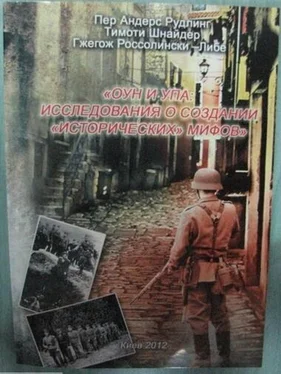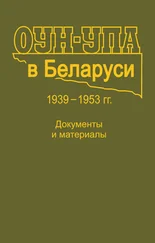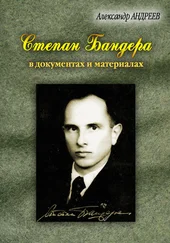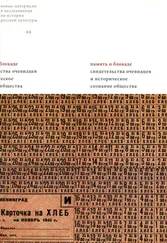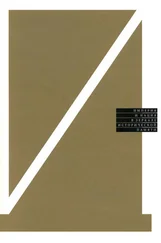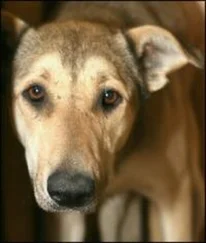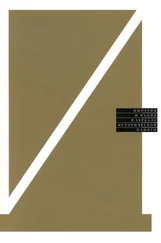Motyl, “Ukraine, Europe, and Bandera,”14.
Wilfried Jilge, “Competition Among Victims? The Image of the Other in Post-Soviet Ukrainian Narratives on World War II,” in Heorhii Kas’ianov, ed., Obraz inshoho v susidnikh istoriakh: mifi, stereotypy, naukovi interpretatsii: Materialy mizhnarodnoi naukovi konferentsii, Kyiv, 15–16 hrudnia 2005 roku (Kyiv: NAN Ukrainy, Instytut istorii Ukrainy, 2008), 66.
This interpretation has found a receptive audience among some pro-OUN and UPA diaspora historians. See, for instance, Canadian Institute of Ukrainian Studies Director Zenon Kohut’s reply to John-Paul Himka “Re: Should Ukrainian Studies Defend the Heritage of OUN-UPA?” February 12, 2010. Dominique Arel’s Ukraine List, UKL 441 (Bandera-OUN and Famine Debates), February 16, 2010: http://www.ukrainianstudies.uottawa.ca/pdf/UKL441.pdf.
For instance, public intellectual Mykola Riabchuk sees no difficulty with the UPA cult, as long as the focus remains on their “ethical rather than ideological values” and as long as their ideology, ethnic cleansing or mass murders are not celebrated. “The UPA fi ghters. are praised fi rst of all for their patriotism and commitment to the national-liberation cause, for their idealism and dedication, for spiritual strength and self-secrifi ce.” Mykola Riabchuk, “Ukraine: Neither Heroes nor Villains: Review of Heroes and Villains: Creating National History in Contemporary Ukraine, by David Marples (Budapest: Central European Press, 2007),” Transitions Online, 6 February 2007.
See, for instance, the interview with Volodymyr V’’iatrovych, Masha Mishchenko, “Pratsivnyk SBU.”
See, for instance Peter J. Potichnyj and Yevhen Shtendera, eds., Political Thoughts of the Ukrainian Underground, 1943–1951 (Edmonton: CIUS and University of Alberta, 1986); Himka, “War Criminality,” 11. See Rudling, “Theory and Practice”; &ada, “Creative Forgetting;” Marples, Heroes and Villains, 298–301; Dietsch, Making Sense of Suffering, 147–176; Grzegorz Rossolinski-Liebe, “Der polnisch-ukrainische Historikerdiskurs über den polnisch-ukrainischen Konfl ikt, 1943–1947,” Jahrbücher für Geschichte Osteuropas 57, no. 1 (2009): 54–85.
Howard Aster, “Refl ections on the Work of Peter J. Potichnyj,” Journal of Ukrainian Studies 21, no. 1–2 (1996): 226–227. Potichnyj largely limits his focus to the period during which OUN and UPA took a more liberal and open position to national minorities. See, for instance, Potichnyj and Shtendera, Political Thoughts of the Ukrainian Underground, a collection of essays partly based upon Mykola Lebed’s archives. Unsurprisingly, there is next to nothing in the Litopys UPA on the topic of the Volhynian massacres in 1943, and total silence on UPA murders of Jews.
Andreas Umland, “Die andere Anomalie der Ukraine: ein Parlament ohne rechtsradikale Fraktionen,” Ukraine-Analysen, no. 41 (2008): 7–10. Émigré nationalists who reestablished contacts in Ukraine, used to clandestine work, were often disappointed the organization and nature of the nationalists in the old country. See, for instance, Sukhovers’kyi, Moi Spohady, 237.
For examples of this narrative, see Petro Sodol, “Foreigners in the UPA,” Ukrainian Quarterly 58, no. 4 (2002): 342–348; Volodymyr Kosyk, “Organizational Conditions and the Initial Struggle of the Ukrainian Insurgent Army (UPA),” Ukrainian Quarterly 58, no. 4 (2002): 310–325; Volodymyr Viatrovych, [V’’iatrovych] “The Communist Alliance against the Ukrainian Insurgent Army (UPA),” Ukrainian Quarterly 58, no. 4 (2002): 326–341; Herbert Romerstein, “The KGB Disinformation Campaign Against Ukrainians and Jews,” Ukrainian Quarterly 58, no. 4 (2002): 349–360.
Serhiichuk, Nasha krov — na svoii zemli, 3, 42, 77.
Vasyl’ Derevins’kyi, Stavlennia OUN(b) i UPA do susidnikh narodiv ta natsional’nykh menshyn (Kyiv: Natsional’na Akademiia nauk Ukrainy, Instytut istorii Ukrainy, 2006), 44.
Serhii Hrabovs’kyi, “Tak proty koho zh voiuvav Shukhevych u Bilorusi?” Ukrains’ka Pravda: http://www.pravda.com.ua/news/2007/11/13/66774.htm (accessed November 18, 2007). On Hrabovs’kyi’s celebration of OUN-UPA and Waffen-SS division Galizien, see Marples, Heroes and Villains, 231–232.
Hunczak, “Problems of Historiograhy,” 136.
Morton Weinfeld, Like Everyone Else. but Different: The Paradoxical Success of Canadian Jews (Toronto: McClelland & Stewart, 2001), 213–214; Daniel Mendelsohn, Lost — A Search for Six of Six Million (London: HarperCollins, 2007), 99; Golczewski, “Shades of Grey,” 114–155.
See, for example, Himka, “The Ukrainian Insurgent Army and the Holocaust,” 15, citing the USC Shoah Foundation Institute for Visual History and Education, 20586 Jack Glotzer, 12–15; Spector, The Holocaust of Volhynian Jews, 358; Ahron Weiss, “Jewish-Ukrainian Relations in Western Ukraine During the Holocaust,” in Peter J. Potichnyj and Howard Aster, eds., Ukrainian-Jewish Relations in Historical Perspective (Edmonton: CIUS and University of Alberta, 1990), 409–420; Weiner, Making Sense of War, 270–271.
See Mykola Lebed, UPA: Ukrains’ka Povstans’ka Armiia (n.p. 1946), 35–36; for other early claims on Jews in UPA, see Petro Mirchuk, Ukrains’ka Povstans’ka Armiia,1942–1952 (Munich: Cicero,1953),69–72.
Lebed’, Ukrains’ka Povstans’ka Armiia, 35–36, cited in Friedman, “Ukrainian-Jewish Relations,” 204.
Leo Heiman, “We Fought For Ukraine — the Story of Jews Within the UPA,” Ukrainian Quarterly, vol. 20, no. 2 (Spring 1964):33–44.
Dr. Stella Krentsbakh, “Zhyvu shche zavdiaky UPA,” in Petro Mirchuk and V. Davydenko, eds., V riadakh UPA: Zbirka spomyniv buv. Voiakiv Ukrains’koi Povstans’koi Armii (New York: Nakladom T-va b. Voiakiv UPA v ZDA i Kanadi, 1957), 342–349.
“The questionable source mentioned here is the ‘memoir,’ allegedly by a Jewish woman named Stella Kreutzbach, in Nasha Meta, Toronto 27 and December 4, 1954; Ukrainske Slovo (Buenos Aires), October 10, 1954; Kalendar Almanakh na 1957 Rik (Calendar Almanac for 1957) (Buenos Aires): 92–97. Kalendar also features an article by Dmitry Andreyewsky (pp. 88–91), in which he states that Stella Kreutzbach went to Palestine after the war, where she was later employed as a secretary in the foreign ministry, and that several weeks after the publication of her memoirs in the Washington Post (which the Ukrainian publication credited for fi rst releasing the memoirs) she was mysteriously shot and killed. I checked the Washington Post of that period and did not fi nd the memoirs. At my request, Dr. N. M. Gelber of Jerusalem made inquiry in the foreign ministry there; the reply was that the ministry had never had an employee by that name and that such a case of homicide was entirely unknown. Moreover, a careful analysis of the text of the ‘memoirs’ has led me to the conclusion that the entire story is a hoax. Similarly, the Ukrainian writer B. Kordiuk labels the story ‘a mystifi cation’; he states that ‘none of the members of the UPA’ known to him ‘ever met or heard of her.’” Philip Friedman, Roads to Extinction: Essays on the Holocaust, ed. Ada June Friedman, introduction by Salo Wittmeyer Baron (New York: Conference on Jewish Social Studies, Jewish Publication Society of America, 1980), 203–204.
Читать дальше
